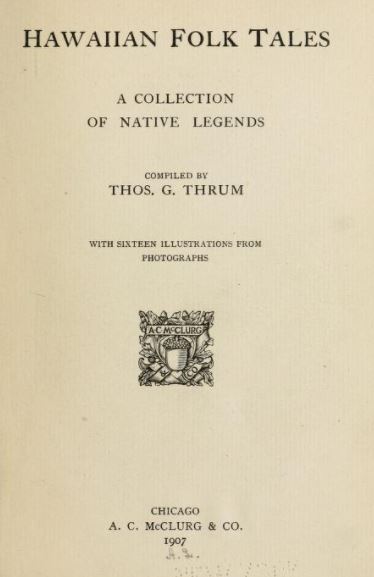‘Hawaiian Folk Tales’ PDF Quick download link is given at the bottom of this article. You can see the PDF demo, size of the PDF, page numbers, and direct download Free PDF of ‘Hawaiian Folk Tales’ using the download button.
Hawaiian Folk Tales By Thos. G. Thrum PDF Free Download

Hawaiian Folk Tales
Pointing to the fact that the account in Genesis is more true to nature, Judge Fornander nevertheless examined whether this fact “may not indicate that the Hebrew text is a later version of an older but once common tradition”. amendment”?
The greatest antiquity is claimed for Hawaiian traditions concerning events following the creation of man.
“In one of the sacrificial hymns of the Marquesans, the ‘red apple eaten at Naou’ was repeatedly mentioned when human victims were offered …
and the ‘forbidden apple of Atea’ as the cause of death, war, pestilence, famine and other calamities could only be avoided or atoned for by the sacrifice of human victims.
The close connection between the Hawaiian and Marquesan legends suggests a common origin, and that origin may be nothing more than that from which also arose the Chaldean and Hebrew legends of sacred groves, defiance and the Fall.
Compared to the Hawaiian myth of Kanaloa as a fallen angel opposed to the great gods as the spirit of evil and death in the world, the Hebrew legends are more vague and uncertain about the existence of an evil principle.
The serpent of Genesis, the devil of Job, Hillel of Isaiah, the dragon of the Apocalypse – however, all point to the same underlying idea that the first cause of sin, death, evil and plagues was to be found in disobedience and rebellion against God.
They appear as separate scenes of a once grand drama which in ancient times occupied the attention of mankind, and of which, it is strange to say, the clearest summary and most coherent recollection, ever , are found in Polynesian traditions.
It is probably futile to inquire with whom the legend of an evil spirit and its operations in heaven and [30]earth originated.
The next night the four prisoners had dreams.
The first dreamed that he saw a ripe ohia (native apple), and his spirit ate it; another dreamed that he saw a ripe banana, and his spirit ate it; the third dreamed that he saw a boar, and its spirit ate it; And the fourth dreamed that he, awake, saw him squeezing the juice, and his soul drank it.
The first three dreams related to food were interpreted unfavorably by Waikalenuiiku, and told the dreamers that they should prepare to die.
The fourth dream, related to drinking, he interpreted to indicate liberation and life.
According to the interpretation the first three dreamers were killed, and the fourth was saved.
Later this last dreamer told the country’s king Kamohoa’ali how wonderful Waikalenuiiku’s skill in interpreting dreams was, and the king sent him out of prison and made him a major chief in his kingdom.
Judge Fornander, alluding to this legend, gave the name, however, Aukelenui-a-iku, and added to it a description of the hero’s journey to the place where the water of life was kept {ka-wai-ola-loa-a – Kane) obtained it and with it revived his brothers, who had died by drowning a few years earlier.
Another notable similarity is that in the legend of Ke-ali-waha-nui Judge Fornander is told: “He was the king of the country called Honua-a-lalo. He oppressed the Menehune people.
| Author | Thos. G. Thrum |
| Language | English |
| No. of Pages | 336 |
| PDF Size | 11.4 MB |
| Category | Story |
| Source/ Credits | archive.org |
Hawaiian Folk Tales By Thos. G. Thrum PDF Free Download
